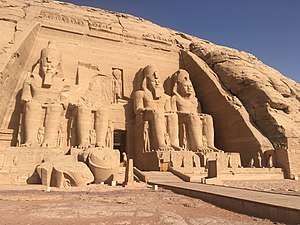Abu Simbel
Abu Simbel (also Abu Simbal, Ebsambul or Isambul; Arabic: أبو سنبل, romanized: Abū Sinbal or Arabic: أبو سمبل, romanized: Abū Simbal) is a village in the Egyptian part of Nubia, about 240 kilometers southwest of Aswan and near the border with Sudan. As of 2012, it has about 2600 inhabitants. It is best known as the site of the Abu Simbel temples, which were built by King Ramses II.
Name
The name Abu Simbel is European, a cacography of the Arabic Abu Sunbul, due in part to assimilation. Abu Sunbul is itself a derivative of the ancient place name Ipsambul.[1] In the New Kingdom period, the region in which the temple was built may have been called Meha, but this is not certain. About 20 km southwest of Abu Simbel was the small village of Ibshek, which was somewhat north of the Second Cataract of the Nile, in present-day Sudan (Wadi Halfa Salient) flooded by Lake Nubia, near the border with Egypt.
Location and climate
Abu Simbel is in southern Egypt, not far from the border with Sudan. It is administratively part of the Aswan Governorate. The Sudanese border is only about 20 kilometers away to the southwest; the border departs from the 22nd parallel here and forms the Wadi Halfa Salient. However, the course of the border is disputed; Egypt claims the territory of the Wadi Halfa Salient up to the 22nd parallel in the south. The nearest city, Wadi Halfa, is located 65 kilometers southwest of Abu Simbel in Sudanese territory, on the east bank of Lake Nubia, the Sudanese name of Lake Nasser. The city was, like the Temple of Abu Simbel, relocated onto higher ground due to the flooding caused by the filling of the reservoir.
Abu Simbel is linked to the governorate capital of Aswan by a road that passes west of Lake Nasser, through the Libyan Desert. It is used predominantly by tour buses bringing visitors to the Abu Simbel temples, but it also has importance for the irrigation projects in the parts of the desert situated near the reservoir. Lake Nasser is navigable, so Abu Simbel is also reachable from the lakeside. A few cruise ships navigate the lake upstream of the Aswan Dam. The village is reachable by air via the Abu Simbel Airport.
Abu Simbel is located in one of the warmest and driest regions of Egypt. In the summer months, the high temperatures are easily 40 °C on average. Despite the great temperature differences between day and night, temperatures in summer seldom fall below 20 °C. Winters are mild with highs around 25 °C, when temperatures can sometimes fall below 10 °C at night. Precipitation is so rare here that it is impossible to state a "rainy season" for Abu Simbel.
History
In the past, Abu Simbel was located on the west bank of the Nile between the first and second Cataracts of the Nile. Cataracts are rapids caused by boulders or rock sills; they were only passable with difficulty by Nile ship traffic, especially at baseflow. Today both cataracts near Aswan and Wadi Halfa are covered by Lake Nasser, which is named after Gamal Abdel Nasser, Egyptian president from 1954 to 1970. At the time of Ramses II, the southern border of the realm of the Pharaohs was located near the two cataracts. The construction of the Abu Simbel temple compound there was meant to demonstrate the power and eternal supremacy of Egypt with respect to the tributary Nubia.
The new dam flooded all of Lower Nubia, the inhabitants became homeless and were mostly resettled in the areas of Aswan and Kom Ombo. Only in Abu Simbel was a new village developed with a hotel and airport. Due to a lack of agricultural land the entire population now depends on tourism. Since the turn of the millennium, various projects are underway with the goal of making the elevated desert regions fertile using water from the lake.
